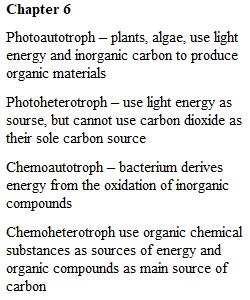


Q Definition Homework for Chapters 6 and 7 Define the following terms: Chapter 6 Photoautotroph Photoheterotroph Chemoautotroph Chemoheterotroph Obligate aerobe Obligate anaerobe Facultative anaerobe Aerotolerant anaerobe Nitrogen fixation Psychrophiles Mesophiles Thermophiles Halophiles Barophiles Quorum sensing Defined media Complex media Selective media Differential media Generation time Chapter 7 DNA rRNA mRNA tRNA Codon DNA replication Lagging strand Leading strand Okazaki fragments Helicase DNA polymerase DNA ligase Methylation Genotype Phenotype Protein synthesis Transcription Translation Operon Promoter Operator Genes Repressible operon Inducible operon Regulatory gene Frameshift mutation Missense mutation Nonsense mutation Silent mutation Mutagen Transformation Transduction Bacterial conjugation Transposon
View Related Questions